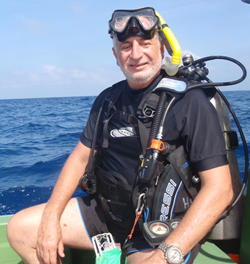![]() Plenary speakers
Plenary speakers

Yehuda (Hudi) Benayahu is Professor (emeritus) of marine biology at the School of Zoology, Faculty of Life Sciences, Tel Aviv University. He received his academic degrees from Tel Aviv University. After a postdoc at Florida International University (USA) he joined TAU where he became a full professor. He served as the Head of the School of Zoology, Head of the Porter School of Environmental Studies, member of the Central University Committee and Incumbent - The Israel Cohen Chair in Environmental Zoology. His major research interest are coral reefs, specifically soft corals (Octocorallia), and considered as a world renown expert on this group. He led and participated in national and international scientific expeditions to numerous Indo-Pacific reefs in which he conducted SCUBA diving. He has been actively involved in a variety of national and international collaborative projects funded by national, EU, USA and other agencies. His research deals with soft coral taxonomy, ecology, life history, association with photosynthetic symbiotic algae and response to global change. Special projects have been dedicated to several acute environmental issues in the coastal marine realm. Efforts are done towards discovery of new soft coral taxa and exploring their biogeographic distribution and invasiveness capabilities. So far, he described ~85 new soft coral species to science, mostly collected by him, from shallow reefs down to mesophotic depth. He supervised ~65 PhD and MSc students and is the author of >235 peer reviewed publications.
CORALS REEFS UNDER ANTHROPOGENIC STRESS: THE IMPACT ON SOFT CORALS
Y. BENAYAHU1*, R. LIBERMAN1,2, J.P. RUIZ ALLAIS3, D. BENAYAHU4
1School of Zoology, Tel Aviv University, Israel, *yehudab@tauex.tau.ac.il
2Nova Southeastern University, Florida, USA
3Fundación la Tortuga, Venezuela, 4Cell and Developmental Biology, Tel Aviv University, Israel
Abstract
Coral reefs comprise coastal light-dependent communities which are drawing our attention due to their environmental importance, esthetic value and being a source for novel compounds and biomaterials. In recent decades, the devastating impact of global change on coral reefs has been highlighted. It is well established that after the reef-building stony corals, soft corals (octocorals) are the second most common benthic component on many reefs, including on mesophotic coral ecosystems (MCE: 30-140 m). We are intrigued to elucidate the ecological and biological function of soft corals under the impact of anthropogenic stressors throughout their entire depth of distribution. Our studies revealed a global pattern where the zooxanthellate taxa predominate the shallow reefs and are missing from the lower MCEs (>65 m), which instead feature the azooxanthellate taxa. It is therefore suggested that physiological constraints of the photosynthetic endosymbionts limit the depth distribution of the zooxanthellate species, while the azooxanthellate ones are of a wider depth distribution ranging from the well-lit shallow reefs down to the deepest fringe of the MCEs. Interestingly, studies on sexual reproduction of soft corals indicate a temporal reproductive isolation between their shallow and MCE populations determined by the timing of the temperature maxima in each depth zone. Therefore, it is suggested that global warming may negatively affect reproductive process and its timing. It should be noted that some soft corals seem more resilient to changing environmental conditions than stony corals, showing persistence under acidification conditions. Since the turn of this century, increasing reports of invasive reef soft corals have been recorded demonstrating dramatic expansion capabilities beyond their original biogeographic range, both within the tropic zone and even to higher latitudes. Such invasives lead to shift in benthic communities, exclusion of other species and formation of marine animal forests (MAFs) where they did not exist before. For example, since the first appearance of the invasive Unomia stolonifera on the Venezuelan reefs, it has dispersed immensely while overgrowing any natural hard substrate, including stony corals and seagrass. We revealed that this species is indigenous to the Indonesian reefs and it is likely that the source of introduction is aquarium release. U. stolonifera dominates all the studied Venezuelan sites, featuring cover of 30 - 80% of the reefs, far above that of the native corals recorded prior to the invasion event. Its dispersal has been intensified by drifting of detached colonies, by colonies settled on detached fragments of sea grass and additionally by colonies entangled on fish nets and consequently translocated. The findings explicitly demonstrate that this invasion is causing severe ecological damage to the marine ecosystem. Recently, Unomia biogeographical expansion has been further recorded also in Cuba and in Pearl Harbor (Hawaii). In summary, there are growing evidence that anthropogenic pressures cause transition in both reef community structure and function and seem to favor soft corals.
Keywords: Global Warming, Ocean Acidification, Ecological Shift, Coastal environment, Invasive Species

